Index

Review: Gelid obviously means business
Thermal Solutions specialist GELID Solutions revealed the first tower case from its GAMER product line. We got the case and tested it, so today we will share our experience with our readers.
Dark Force measures 207mm in width, which means the company thought about users who like tall CPU coolers. Gamers usually make sure that a case has enough room for their graphics cards and whether it packs good cooling. Thankfully, Dark Force has enough room to fit 29cm long graphics card, but if you need more, you can remove the HDD cage, leaving 410mm of room.
The case is relatively light and weighs only 9.2kg. GELID Solutions used 0.7mm SECC steel for the body and threw in an acrylic side window and plastics-metal mesh combination for front and top panels.
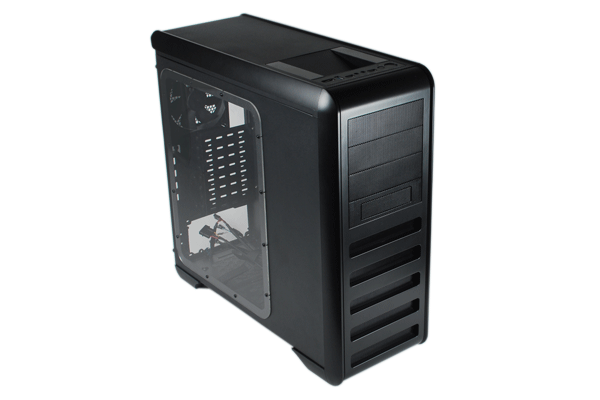
We like the look of the box - it is refreshing and descriptive. Each important feature of the Dark Force computer case is written on the box.
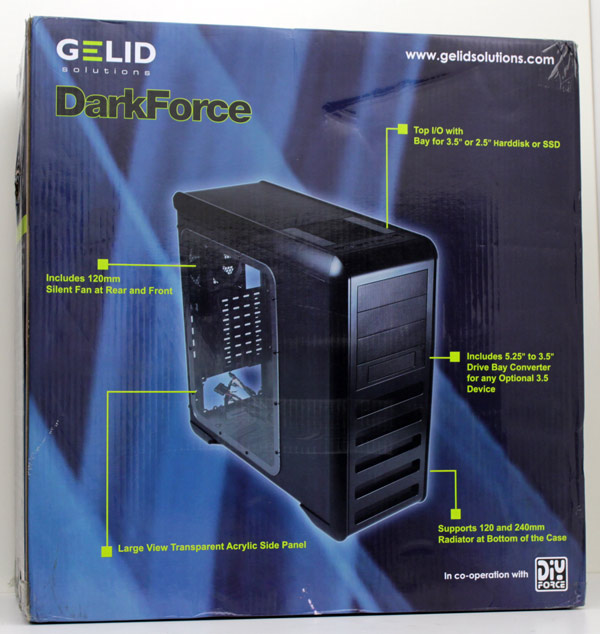
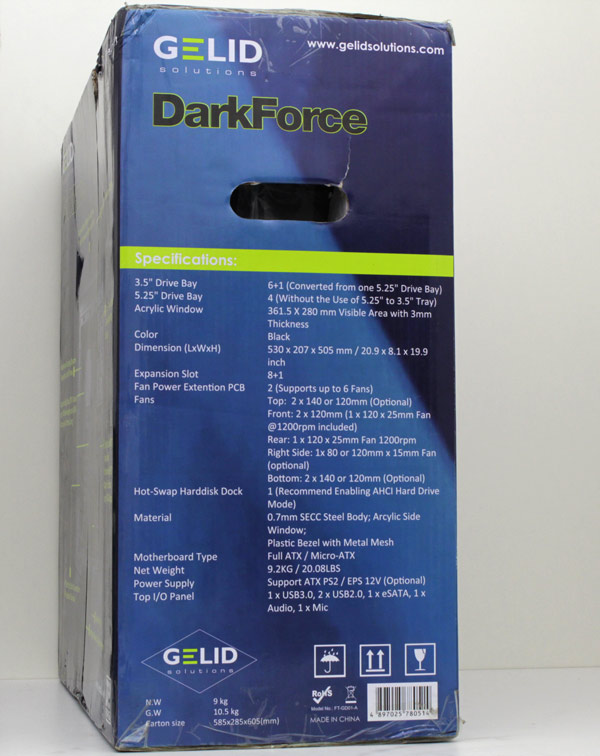
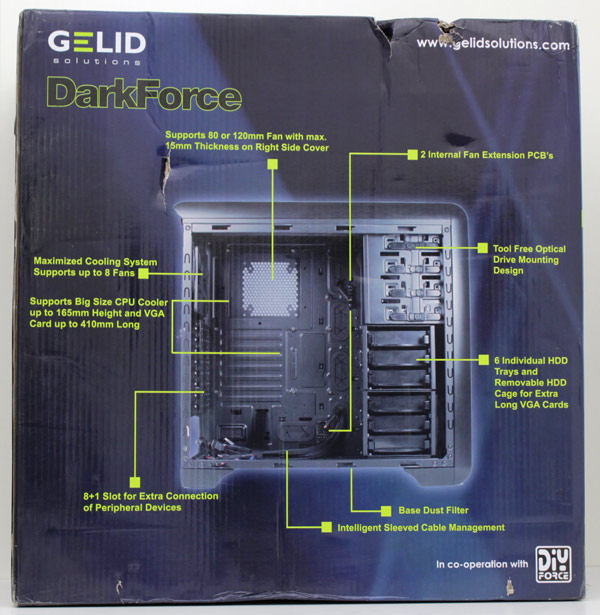
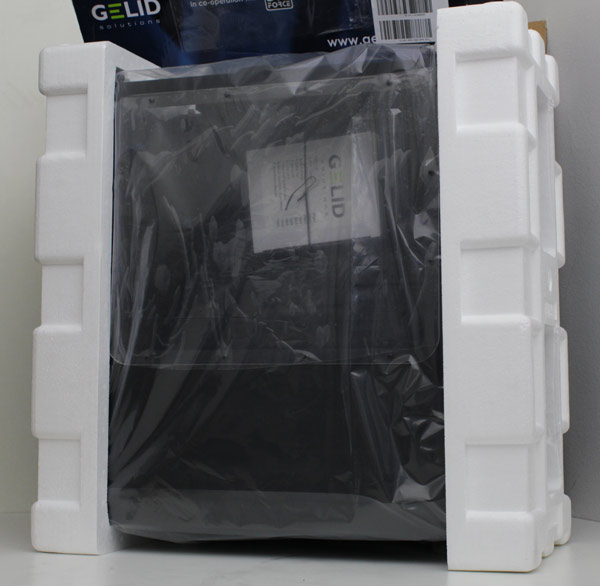
The case was wrapped in double plastic, which we don’t particularly like for environmental reasons.
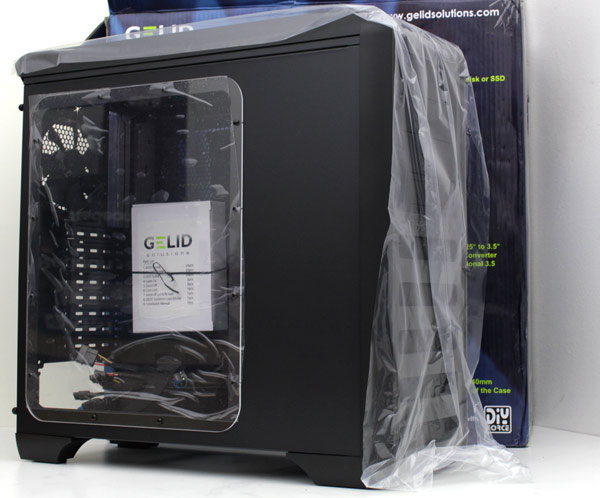
As you can see from the picture, the package also holds a box with some screws. User manual is descriptive and packs plenty of pictures.
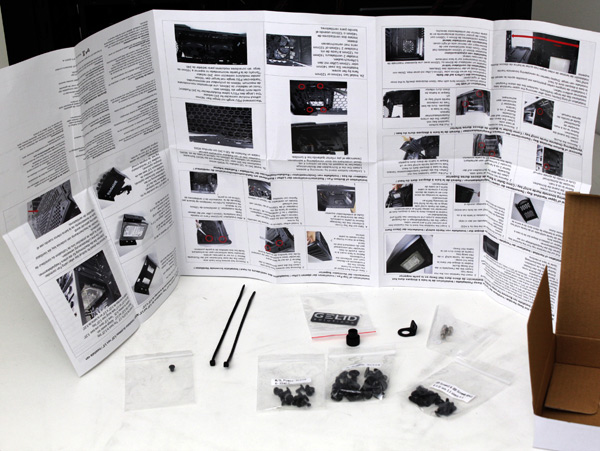
The front panel is made mostly of plastic combined with dense metal mesh. Dark Force has four 5.25 bays. One of the bays can hold 3.5” devices when strapped with a 5.25“ to 3.5“ drive bay converter.
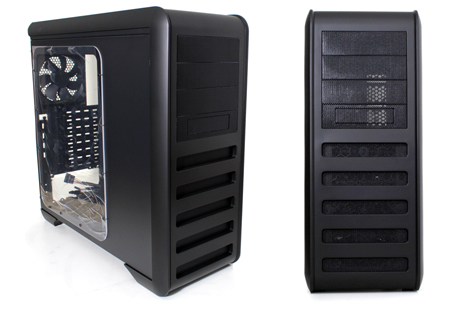
The same metal mesh is used for bay covers and for the lower part of the front panel. For inserting optical drives we will need to remove front panel. A simple tug on the bottom of the panel will do the trick.
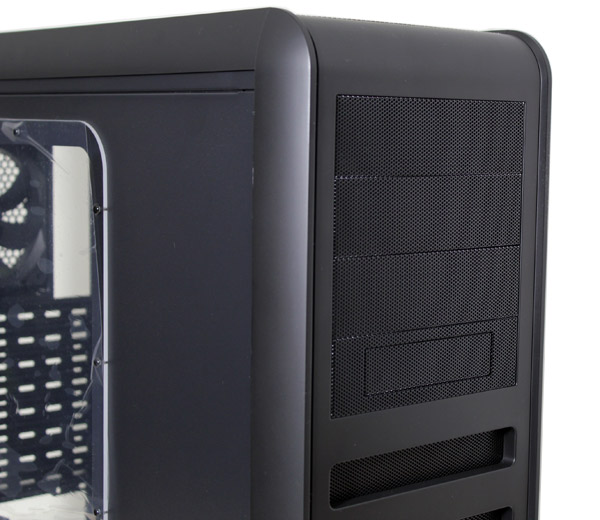
The front fan is protected only by the metal mesh on the panel, although we’d rather have a denser filter such as those on the bay covers. After some closer inspection, we realized that dust filter holders are there but someone obviously forgot to insert the filter.
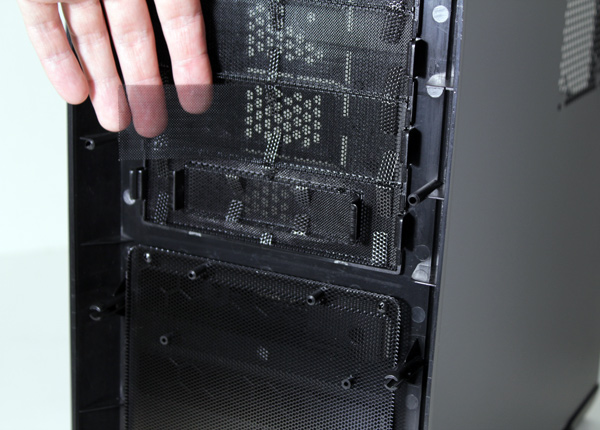
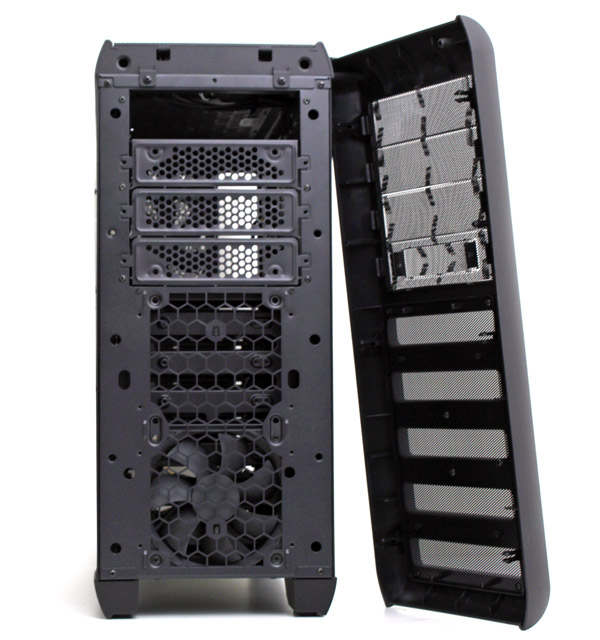
One GELID Solutions 120mm Silen 12 fan (1200RPM and 12V / 0.08A) serves as the intake fan, and it is placed on the bottom front.
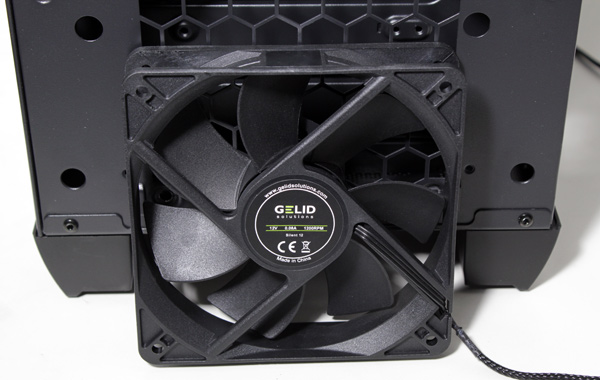
The power and reset keys are placed on the top panel. In the same line you will find 1 x USB 3.0, 2 x USB 2.0, 1 x eSATA, 1 x Audio and 1 x Mic.
There is a hot-swap docking station on the top panel for easy connection of 3.5” or 2.5” HDD or SSD. It is recommended to enable AHCI hard drive mode in motherboard bios before inserting drives into the dock.
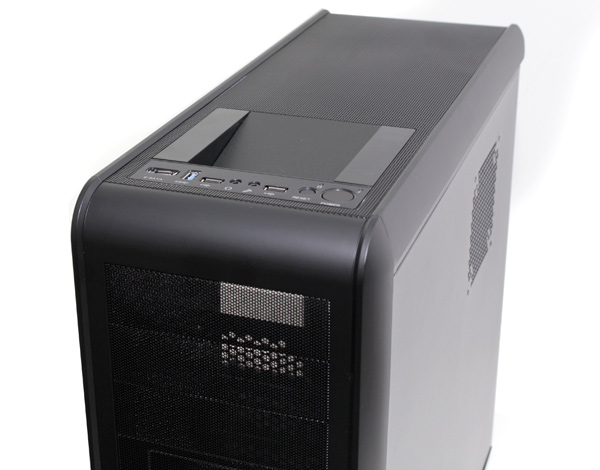
The top panel can be removed as well. As you can see, most of the panel is made of plastic and metal mesh. Now we know why this case weighs only 9.2kg.
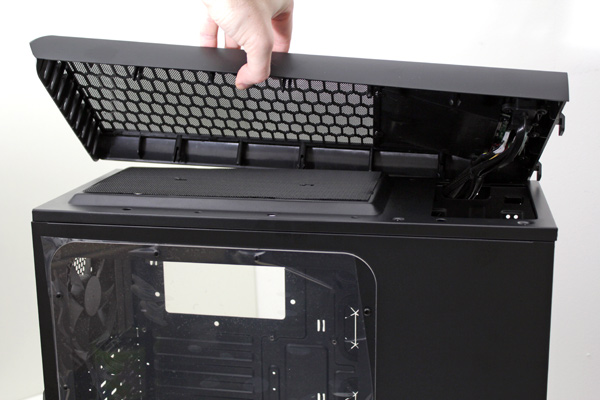
The top panel can house two 120mm fans, but they are not included by default. We found the dust filter here, something we missed on the front panel. We tried to strap the top panel filter on the front panel and almost made it – almost.
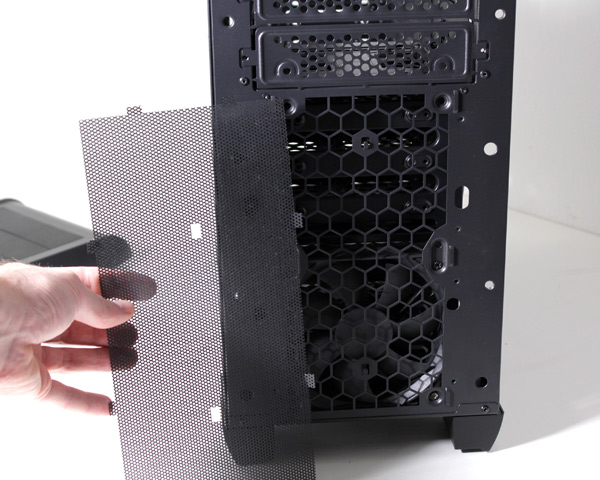
There is bunch of wires going from the I/O panel, but GELID Solutions have done nice job here by sleeving all cables in black.
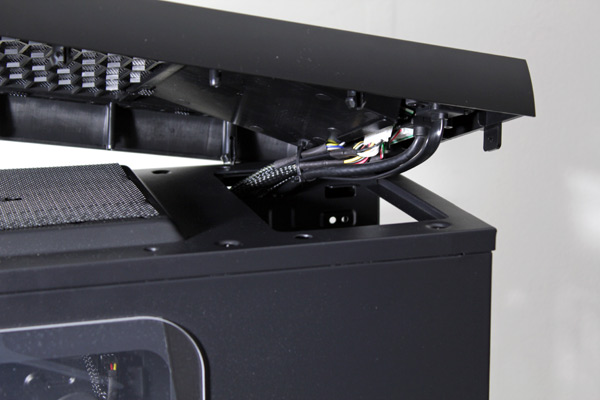
There is a small plastic cap which protects connectors on the hot-swap dock. You can check out how GELID Solution laid out the I/O panel on the picture below.
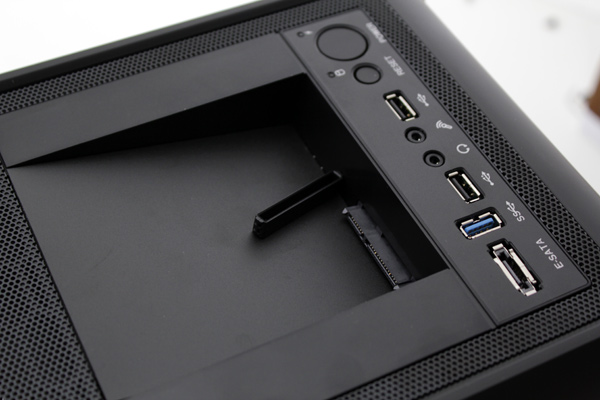
The left side has a large transparent acrylic panel. It measures 361.5 x 280mm and is 3mm thick, making it easy to see every component inside. Case modders and some gamers will probably welcome the panel but GELID Solutions will probably provide a solid side panel if there is demand for it. For the time being though, this is the only version available.
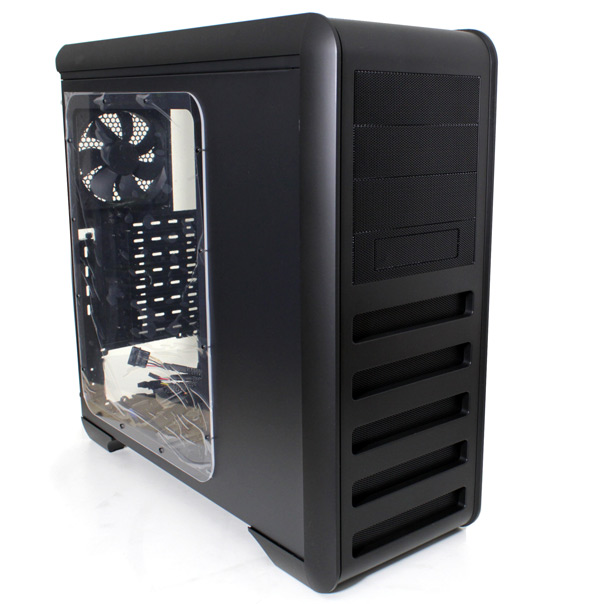
The right panel has a hole for the 80 of 120mm fan, which must be 15mm thick.
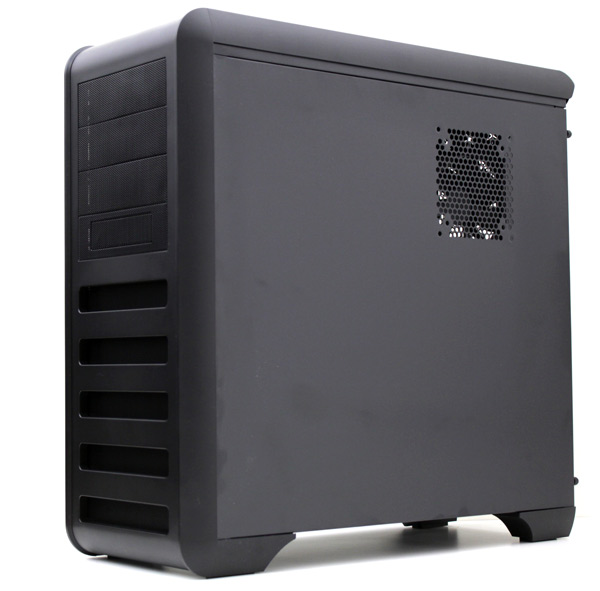
The acrylic window is protected by a thin nylon film which should be taken off after inserting components in the case. Side panels are held in place by thumb screws.
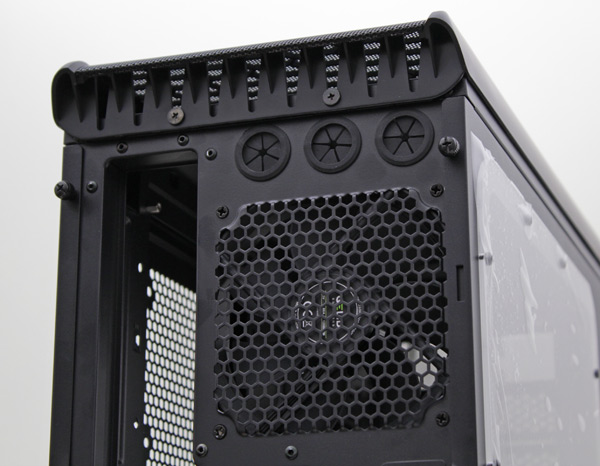
The panels are tough and rigid. They are made from 0.7mm steel but they are fingerprint magnets.
We could not remove the left panel on the first try as it was stuck. As you can see from the picture below there are white traces left on the metal surface, which are a result of our pulling. However, after removing the panel ten to fifteen times, sliders softened up and removing it was not that hard any more. The right panel is closed normally.
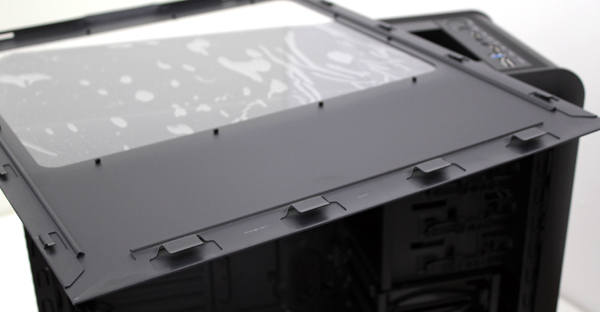
The rear panel includes one 120mm fan, just like the one on the front panel.
Dark Force has 8+1 expansion slots and three holes for water cooling. A glance at the rear panel reveals an important thing – Dark Force is wider than classic midi-tower cases. The right side panel isn’t very close to the I/O panel, which is good as it means extra room for cable management. The expansion slot covers features air inlets and they are fixed with thumb screws, which are also used to lock expansion cards.
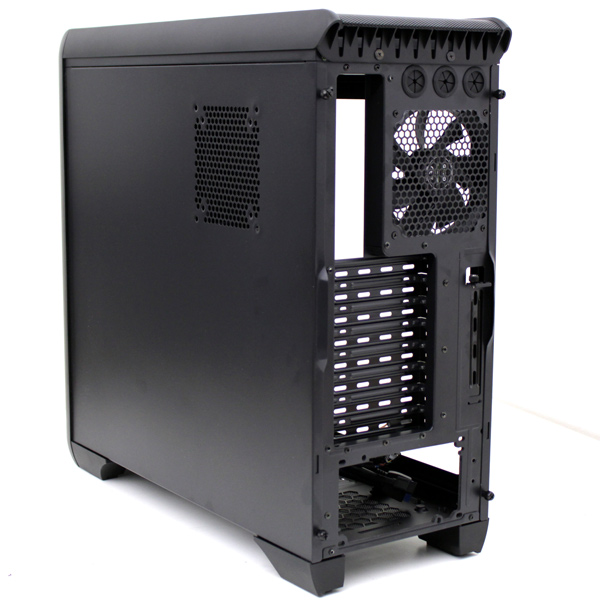
Bottom panel supports 120 and 240mm radiators. You can optionally place one 120/140mm fan here. There are two dust filters on the bottom, one below the fan exhaust and one below the PSU. Filters cannot be easily removed and it is easier to clean the dust from the surface.
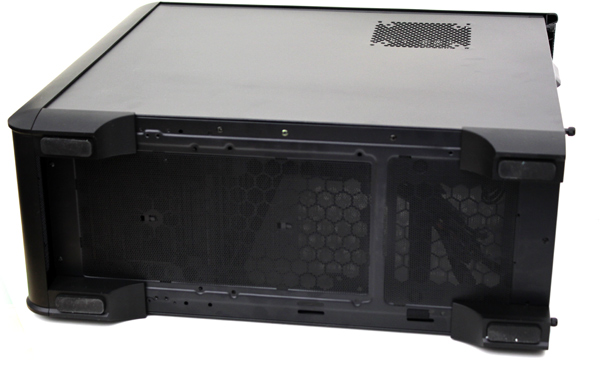
The feet are made with anti-vibration rubber coating underneath to suppress vibration noise. The feet are stable and tall enough to allow the air to be drawn in from the bottom of the case.
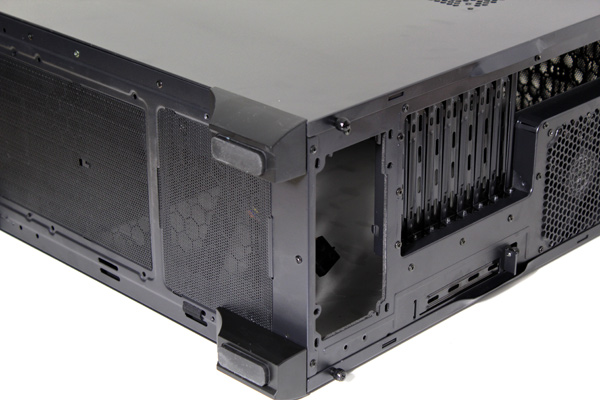
Dark Force supports full-ATX / micro-ATX motherboards. The case is enough wide to house CPU coolers up to 165mm in height. Graphics cards are limited to about 29cm length, but it will support up to 410mm length once the HDD cage is removed.
You can maximize cooling Dark Force’s cooling by adding more fans, as the case supports up to 8. However, we’re not happy with the fact that Dark Force comes with only two preinstalled fans. Whether GELID Solution did their best is arguable, as many will agree. Knowing that GELID Solutions fans are quality parts, we were quite disappointed not to see at least three fans as standard. But let us look at the bright side.
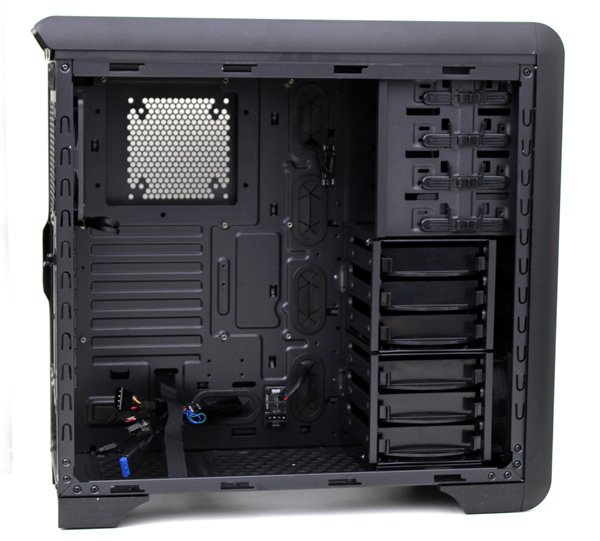
There are two removable HDD cages, each with three bays for 3.5” or 2.5” drives.
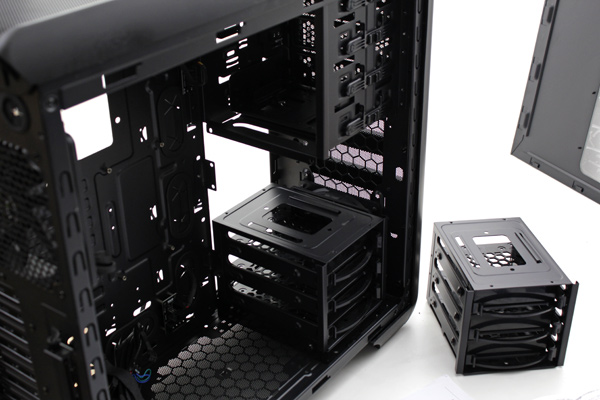
The lower HDD cage can be also removed leaving room for 120 or 240mm radiators on the bottom panel.
Looking at how we grabbed the bay may look a bit funny, but it’s the easiest way to take it out.
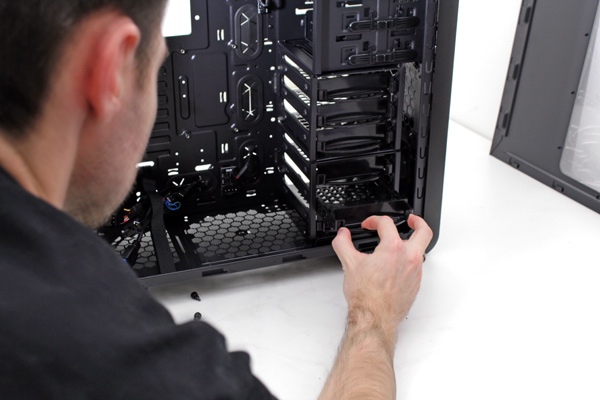
You’ll find antivibration grommets in every bay.
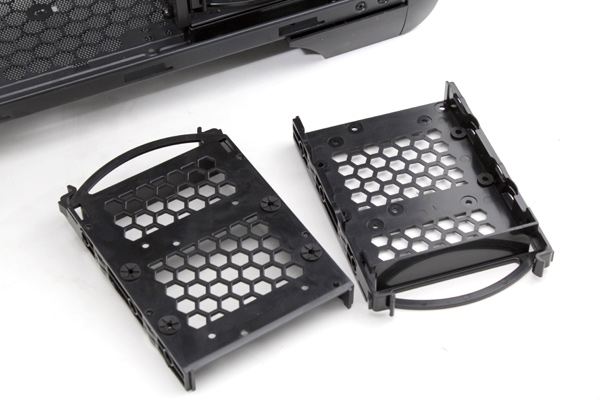
You can place the seventh 3.5” drive in one of the 5.25” bays using the included converter. As we said earlier, the top panel features one external hot-swap dock, meaning that Dark Force offers eight 3.5” and eight 2.5” bays.
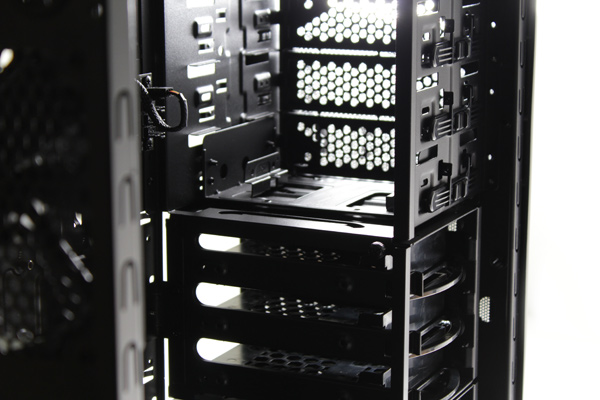
Installing 5.25” devices is easy except when installing it the topmost bay. There are some cables hanging from the I/O panel, which makes inserting 5.25” drives in the top bay a bit difficult. The toolles mechanism works well.
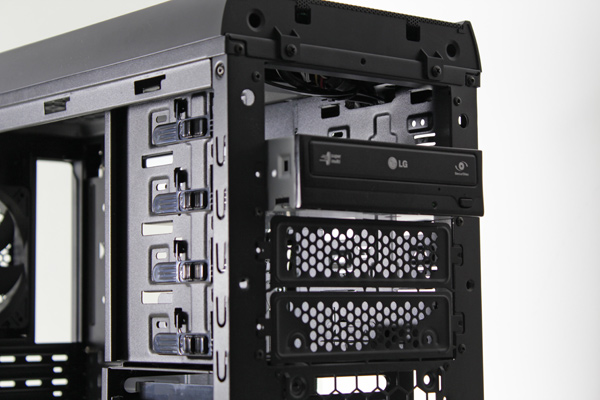
The motherboard tray has a big CPU backplate cutout, but it wasn’t compatible with all of our motherboards. GELID Solutions used rubber on cable management holes. The holes are not that big but there are enough of them to make cable management easy.
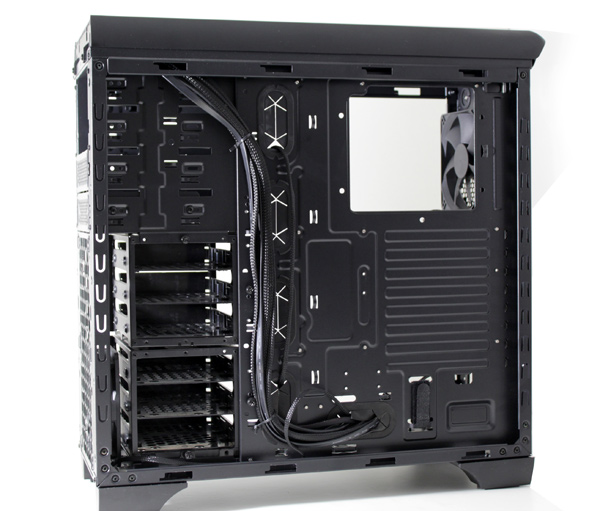
All cables that come from the I/O panel, as well as fan cables, are sleeved for better look and easier cable management. We have about 150mm free space to work with in the back.
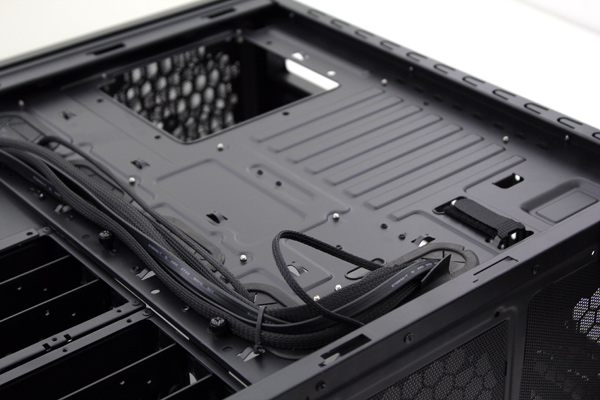
It’s not a common feature, but Dark Force supports 80mm or 120mm fans with maximum 15mm thickness on the right side cover. You can see that the spot for this thin fan is just behind the motherboard tray cutout.
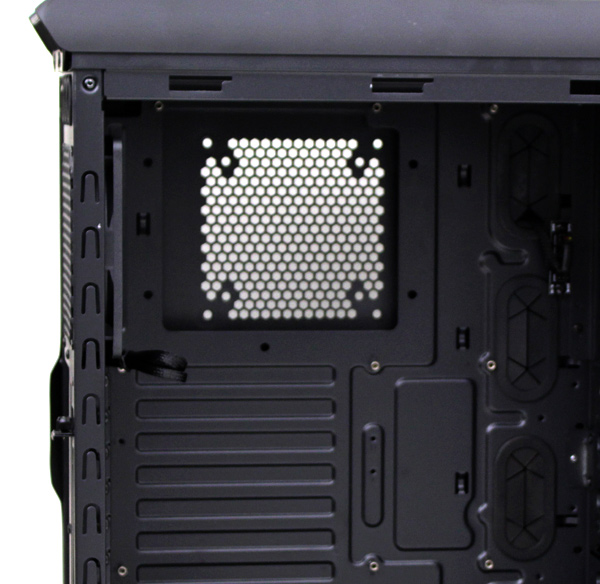
Two internal fan extension PCBs will come handy when installing additional fans, but it would be nice to see some fan controllers here as well.
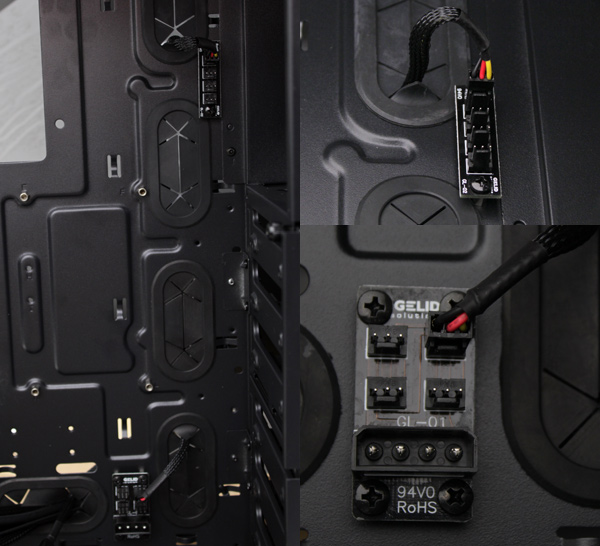
We used the Velcro Fastener on the picture below to tie and hold some cables, but its real use is to keep the PSU in place.
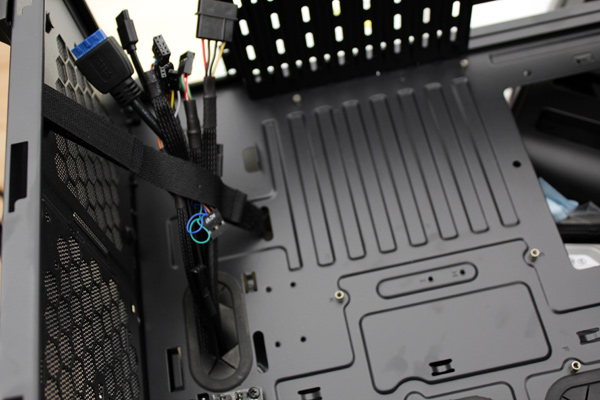
Stand-off screws come pre-installed for full ATX motherboards. We really liked was the small thumb screw dubbed quick fix tool, which was made for easy stand-off removing. GELID Solutions opted on internal USB 3.0 pin connector.
Dual or even triple GPU configuration is an option here, as we have 8 expansion slots on our disposal. The slots have small exhausts for better ventilation. The cards are held in place by large thumbscrews. There is also a ninth expansion slot placed on the side.
Dark Force took Asus’ Rampage II Extreme motherboard (269x305 mm, 10.6" x 12"). The case has a few cable management holes in the motherboard tray but, unfortunately, our Rampage II closed off most of them. However, Dark Force won’t have trouble with any standard ATX board (Rampage II Extreme is about 2cm wider than standard.
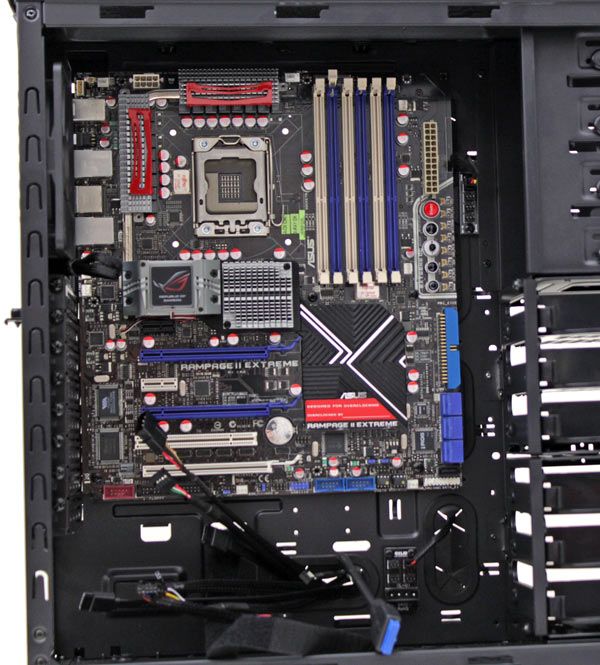
EVGA X58 FTW3 motherboard left more cable holes open, but we still had difficulties unscrewing our CPU cooler backplate.
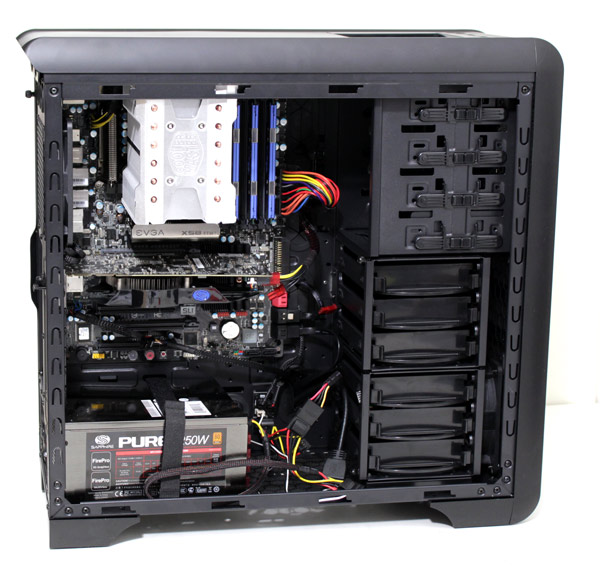
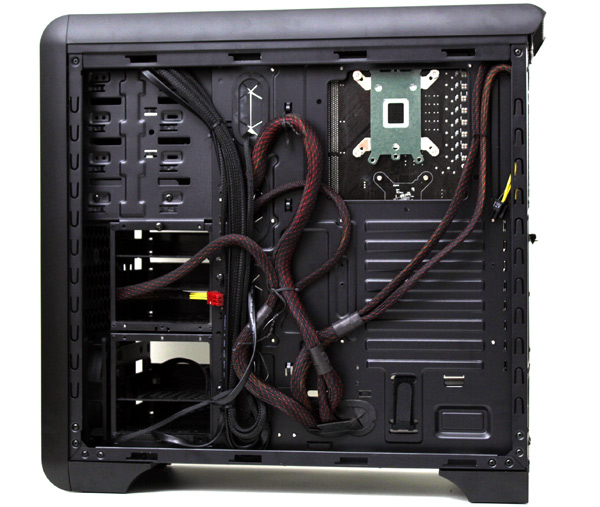
The PSU is on the bottom of the case and Gelid left a rubber seal that minimizes vibration and makes for a tighter fit. GELID also used Velcro Fastener that can be used to additionally secure PSUs. In our case, we used it to fix Sapphire’s Pure 1250W – the fastener eased some pressure off the screws that hold it in place.
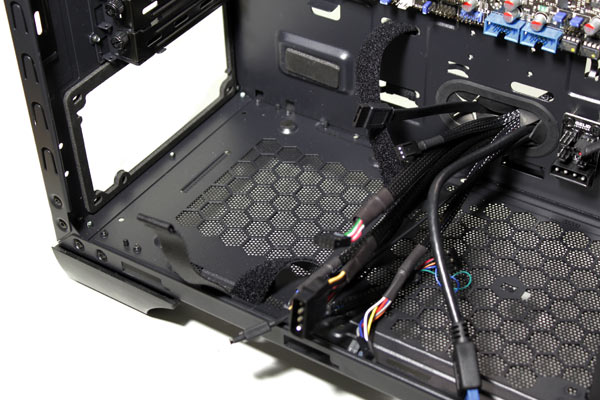
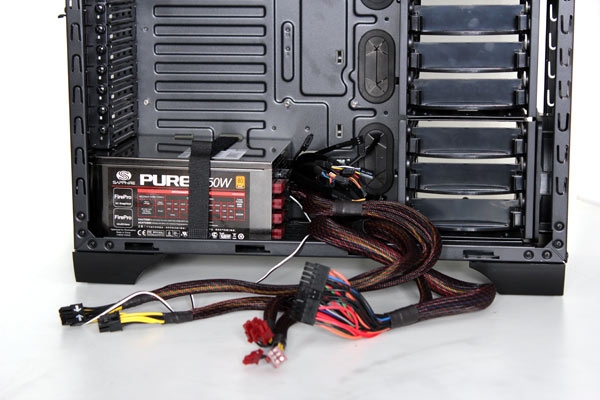
It’s not rare that a case manufacturer underestimates the need for quality rubber grommets that should support the PSU. Dark force has four points with grommets, which are unfortunately very thin and aren’t glued well. As you can see from the photo below, they remained on the PSU when we took it out.
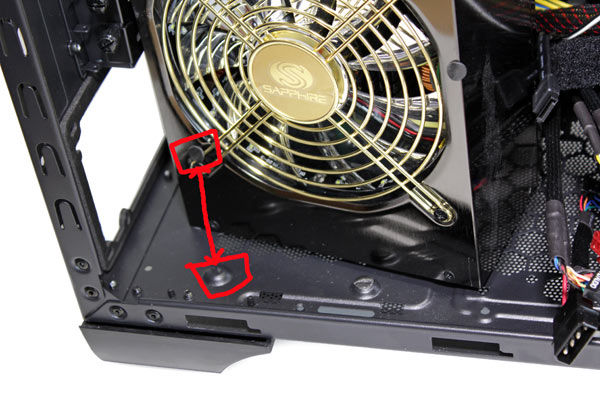
The PSU filter is a mesh that can be taken off once the case is laid on the side, although it’s not quite what we’d call easy.

The rest of our mounting process went without a hitch and our Dark Force was soon ready for action.
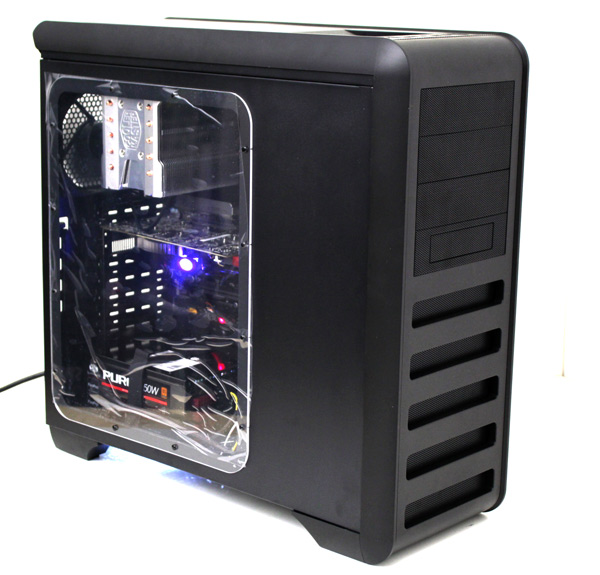
Dark Force comes with two 1200 RPM fans. The fans aren’t loud, but you’ll hear them a bit. Unfortunately, high end gaming components will require better cooling inside the case.
GELID Solutions made its first case and we must thank the company for providing us with one of the first test samples of Dark Force. The case currently goes for about €90.
Dark Force will take any graphics cards, even in SLI or Crossfire setups. It has a removable HDD cage, which extends allowed graphics card length even further. The case can house high end CPU coolers up to 16.5cm tall and there is still 1.5cm of room behind the motherboard tray for cable management. The case boasts USB 3.0 and a hot swap bay on the I/O panel, both of which will surely come in handy. So, GELID Solutions strived for all features found on better midi-tower cases. The chassis is rigid and there is a large window on the left side panel that lets you peek inside.
Users that don’t like loud fans in their case can always replace them with aftermarket fans – something GELID Solutions excels in. This is one of the reasons why we were surprised to see only two stocked fans. Furthermore, Dark Force is classified as a gamer case, yet another reason to throw in some more fans.
Truth be told, both of the fans are quiet and provide good airflow, but a powerful gaming system needs the max, which will require more fans. GELID seems to have been aware of this and they left room for a total of eight fans.
Dark Force is a good case that meets the latest standards, but the pricing does seem a bit too high. It is well worth noting that this price range and product segment are not the easiest to start from, so GELID Solutions is definitely off to a great start. The case is a price adjustment and perhaps a few more fans away from being an even more attractive and competitive product, but we still believe it has what it takes to win many users over.



